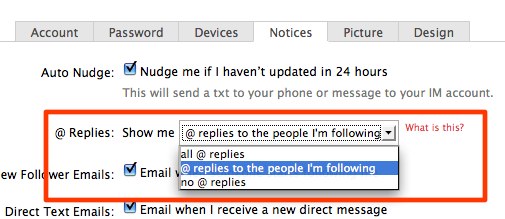Remedial Twitter
May 13, 2009 at 6:40 PM by Dr. Drang
I’ve decided that one of Twitter’s biggest problems is that its top people have a very poor grasp of English.
If you’re a Twitter user, you probably know that a big controversy has blown up over a recent change in the way users receive @replies. There used to be a setting that gave you some control over the kinds of @replies you’d see in your friends’ timeline (i.e., your home page). That setting was removed yesterday because it was “undesireable and confusing.” The Twitterites decided which of the three former options was best, and now that’s the (unchangeable) setting everyone has. Because the new setting is the one I was already using, the change hasn’t affected me, but a lot of people are pissed. #fixreplies is currently the top Trending Topic.
Was the old set of options confusing? It depends on how you look at it. The options themselves were actually quite simple.
- Show all @replies written by people I follow.
- Show only @replies written by people I follow to people I follow.
- Show only @replies written by people I follow to me.
But the way these options were presented on the Settings page was confusing. Here’s what they looked like (in an image I lifted from this Mashable post:

Did the first option show all @replies? No.
Did the second option show all @replies to people you were following? No.
Did the third option show no @replies? No.
I wonder why it was so confusing?
There was a help page for these settings, but it was itself poorly worded. In my first days on Twitter, the only way I was able to understand these options was by testing them. The confusion was not with the system’s workings, it was with the system’s description.
Because of the shitstorm—people using Option 1 don’t like being shifted to Option 2—Twitter is making new changes to mollify those who liked their old settings. In a blog post today, Biz Stone said
So here’s what we’re planning to do. First, we’re making a change such that any updates beginning with @username (that are not explicitly created by clicking on the reply icon) will be seen by everyone following that account. This will bring back some serendipity and discovery and we can do this very soon.
Why are there parentheses in that second sentence? Because Biz Stone doesn’t know what parentheses are for. The clause “that are not explicitly created by clicking on the reply icon” describes an essential distinction between the @replies that will appear on your home page and those that won’t. It has no business being in parentheses, which are meant for nonessential content. It’s as if Stone is writing a program in which @username is the function and that are not explicitly created by clicking on the reply icon is the argument.
if @username(that are not explicitly created by clicking on the reply icon):
include in timeline
else:
exclude from timeline
But he’s not writing a program, he’s writing a paragraph. A paragraph with a syntax error.
I have a sense that Twitter is not exactly hard up for money. Perhaps they could hire a copyeditor.
Update 5/15/09
Yesterday, Biz Stone wrote another blog post about the replies settings. In it, he gives a remarkably clear description of the old default (and now only) setting: “you only see replies by people you follow to people you follow.” Since this is almost exactly the wording I used above, I’m going to take credit for his new coherence.
